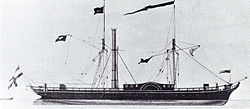City of Constanz (ship, 1840)
|
General plan of the city of Constanz
|
||||||||||||||||||
|
||||||||||||||||||
|
||||||||||||||||||
|
||||||||||||||||||
|
||||||||||||||||||
The town of Constanz was a smooth-deck steamer from Baden , which operated as such on Lake Constance for only 19 years, from 1840 to 1859 . As a non-powered barge in Meersburg , it was then in service for another 62 years from 1866 to 1928, before being demolished in 1985 as a gravel ship Immenstaad after another 57 years . The city of Constance , with a total of 145 years of operation, the longest serving Bodenseeschifffahrt.
City of Constanz (1840-1859)
The city of Constanz was founded in 1840 by the private steamship company for Lake Constance and the Rhine in Konstanz at the Zurich shipyard Escher, Wyß & Cie. commissioned and commissioned in the same year. She was the first ship to bear the name of the old town, after which not only Lake Constance was named in many languages, but also steamships, motor ships and boats, car ferries, work boats and a catamaran . The chimney behind the middle of the ship and a second gaff mast were noticeable , especially their oversized paddle wheel boxes . In strong winds , her seaworthiness was therefore considerably reduced and in 1846 she was stranded . Even a renovation did little to change that. Since the consumption of firewood was also extremely high, it was withdrawn from circulation in 1858 and the steam engine was used in the successor city of Constance , which was commissioned in 1858 . The city of Constanz was officially retired in 1859 after the renovation was completed. The shell of the city of Constanz was used as a covered goods tug Meersburg .
Meersburg (1866-1928)
How and by which owner the ship was used without steam engine, paddle wheels and superstructures after 1859 is not known, because the Meersburg goods tug was only put into service in 1866 by the Grand Ducal Baden State Railways. The width was reduced to 6.72 m, the load capacity was 225 t. Usually she was towed to the ports of destination by scheduled boats . The harbor had to be pounded . When the aft wind was good , rigging with gaff and jib sails was available. After the turn of the century, the expansion of the railway on the north shore of Lake Constance made most of the goods tugboats superfluous. Some were even as workboat continue to be used for various purposes, such as under monument protection standing Gull and Meersburg .
Immenstaad (1928–1985)
The Deutsche Reichsbahn, the new owner since 1920, sold the almost 90-year-old Meersburg goods tugboat to the excavator company Meichle & Mohr in Immenstaad , the new home port , in 1928 . The Bodan shipyard in Kressbronn converted the old shell into the modern Immenstaad gravel ship , which reached a speed of 14 km / h (7.6 kn) with a 90 hp diesel engine. The width increased slightly to 7.20 m. She received a bucket and a wheelhouse. The main deck was deepened in the shape of a trough for loading 160 t of gravel or sand. The raw material was extracted in the bank area in front of the river mouth with three of our own dredgers , transported by up to nine gravel ships to the central crusher and sorting facility at the mouth of the Argen , and from there it was transported by ship to storage locations in the ports of several Lake Constance locations.
Due to funding restrictions, gravel shipping on Lake Constance was almost completely stopped at the end of the 20th century. With the exception of the work ship Ernst , Meichle & Mohr sold or demolished all ships, in 1985 also the Immenstaad with the shell of the city of Constanz . The sheet metal of the ship's side was partly brittle with age and partly already renewed during land inspections. The frames were all still in their original condition from 1840. The ship was not only the one with the longest use on Lake Constance, it was also moved with all types of propulsion in these 145 years: with pegs and sails, in tow, with steam engine and diesel engine - all year round and in all three versions under tough working conditions.
See also
- Steam boat trip on Lake Constance
- Grand Ducal Badische Bodenseedampfschiffahrt
- List of ground sea steamships
- Ultramarine (Marina)
literature
- Werner Deppert: With a steam engine and a paddle wheel. Steam navigation on Lake Constance 1817–1967. Verlag Friedr. Stadler, Konstanz 1975, ISBN 3-7977-0015-6 .
- Dietmar Bönke: paddle wheel and impeller. The shipping of the railway on Lake Constance. GeraMond Verlag, Munich 2013, ISBN 978-3-86245-714-4 .
Web links
Footnotes
- ↑ Medieval spelling of Konstanz
- ↑ Sources: Bönke (see literature) pages 24, 207 and Deppert (see literature) pages 18, 82ff.
- ↑ The change of ownership to state ownership of the Konstanz fleet took place in 1863.
- ↑ Sources: Bönke (see literature) pp. 120ff, 126f, 132, 313 and Deppert (see literature) pp. 46f.
- ↑ 1928: MWM slow runner approx. 500 rpm. 1966: Deutz diesel engine type A8L 714. Reintjes reversing gear
- ↑ The former gravel ship Ernst
- ^ Information from Ultramarin Marina Meichle + Mohr from March 29, 2016.


